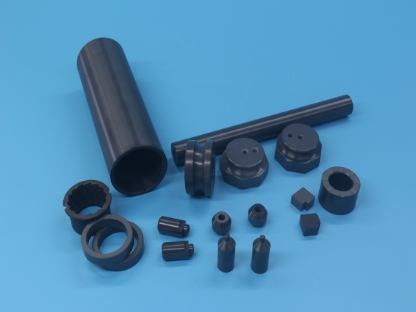Silicon carbide ceramics have been increasingly used in the automotive industry due to their excellent mechanical properties, such as high bending strength, excellent oxidation resistance, good corrosion resistance, high wear resistance and low friction coefficient. Their excellent performance has brought many innovations and improvements to the automotive industry.

sic ceramic parts made by Mingrui Ceramic
The following is a detailed introduction to the application of silicon carbide ceramics in the automotive industry:
1. Engine components
Turbine blades and bearings: Silicon carbide ceramics are widely used in the manufacture of key components such as turbine blades and bearings of engines due to their high hardness and high strength. These components need to withstand high temperature, high pressure and high speed operating environments. The excellent performance of silicon carbide ceramics enables them to meet these requirements, thereby improving the power and efficiency of the engine.
Engine components: Silicon carbide ceramics can be used to manufacture engine valves, valve seats, piston rings, tappets and other parts. The high temperature strength and wear resistance of these parts can improve the performance and reliability of the engine.
Emission control system: Silicon carbide ceramics can be used to manufacture catalyst carriers and filters in automotive emission control systems to improve catalytic efficiency and filtering effects and reduce exhaust emissions.
Braking system: Silicon carbide ceramics can be used to manufacture brake pads and brake discs in automotive braking systems, improving braking performance and wear resistance and extending service life.
Other high-temperature components: Silicon carbide ceramics are also used in high-temperature components of automobiles, such as thermal protection systems and turbine blades. Its high-temperature strength and thermal stability make it perform well in these components.
2. Automotive electronic components
Heat sinks and insulating materials: The application of silicon carbide ceramics in automotive electronic components is mainly reflected in the manufacture of heat sinks and insulating materials. Due to its excellent electrical insulation and chemical stability, silicon carbide ceramics can ensure long-term stable operation of electronic equipment in harsh environments. At the same time, its good thermal conductivity also helps the heat dissipation of electronic equipment.
Sensors: The corrosion resistance and wear resistance of silicon carbide ceramics make it an ideal material for manufacturing automotive sensors. These sensors can work stably in harsh automotive environments (such as high temperature, low temperature, vibration, acceleration, humidity, noise, exhaust gas, etc.), and have the characteristics of small size, light weight, good reusability, and wide output range. For example, silicon carbide ceramic pressure sensors can measure parameters such as air pressure and water pressure, and their measurement range is wide and the accuracy is high.
3. Braking and shock absorbing devices
Brakes: Silicon carbide ceramic brakes have surface hardness close to diamond, strong impact resistance, corrosion resistance, and wear resistance. This brake can minimize the vibration of cars caused by rough roads and improve the braking performance and safety of cars.
Intelligent shock absorbers: Using the positive piezoelectric effect, inverse piezoelectric effect, and electrostrictive effect of sensitive ceramics of silicon carbide ceramics, intelligent shock absorbers can be developed. This shock absorber has the function of identifying the road surface and self-adjusting, which can further improve the driving stability and comfort of the car.
4. Other applications
In addition to the above applications, silicon carbide ceramics can also be used to manufacture automotive turbochargers, exhaust systems and other components to improve the performance and safety of the car. At the same time, silicon carbide ceramics can also be used to manufacture automotive body and interior components to reduce the vehicle's own weight, reduce fuel consumption, and reduce exhaust pollution.

 Moble: +86 18122974730
Moble: +86 18122974730 Phone: +86 746 3386888
Phone: +86 746 3386888 Email: admin@cerampart.com
Email: admin@cerampart.com Skype: +86 18122974730
Skype: +86 18122974730 Wechat: +86 18122974730
Wechat: +86 18122974730